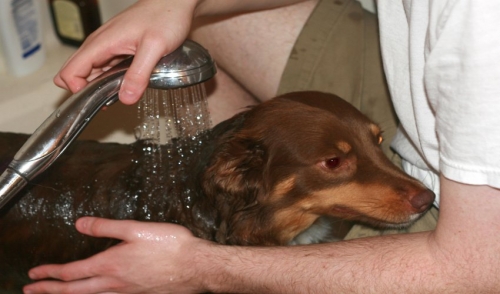{article.name}
Tips for Washing Your Pet

- Share this:
- Share on Facebook
- Pin on Pinterest
- Tweet on Twitter
No matter what type of pets you have – cats, dogs, hamsters, guinea pigs, turtles, etc. – regular baths can be a healthy part of their care, but baths should be given gently to be sure they aren't hurting pets more than helping them.
Bath Frequency
Not all pets need the same number of baths, and depending on the species and its living conditions, some pets may never need intense bathing. Pets with allergies or more delicate skin may do best with fewer baths, while pets that get dirtier more frequently may need more baths. Pet owners must recognize that every pet, however, will have its own distinct odor and may shed skin or fur regularly – these are not issues that can be "cured" with additional baths. No matter how often a pet needs bathing, however, the bath should be done carefully to prevent problems.
Tips for Washing Pets
No matter what type of pet you have or how often you need to wash them, the basic steps for a safe, healthy bath are the same.
- Brush First
Before beginning the bath, brush your pet thoroughly or wipe away any accumulated dirt or debris from its fur, scales or skin so soap and shampoo can be more effective.
- Use the Right Products
Choose the proper shampoos, soaps and conditioners for your type of pet and their grooming needs. Human products are too harsh and strongly scented for use with pets.
- Non-Slip Safety
If you will be bathing your pet in a tub, be sure the surface is stable so they do not slip. Putting down a non-slip mat or towel before starting the bath can give them a good, safe surface.
- Proper Water Temperature
Water that is too hot can scald your pet, while water that is too cold will not clean as thoroughly. Ideally, the water should be just warm to the touch.
- Water Acclimation
Keep the water shallow, and allow your pet to gently touch or sniff the water before beginning the bath so they know what to expect. Gently wet your pet, watching for signs of stress and going slow so they feel safe and comfortable.
- Use the Proper Tools
Depending on your type of pet and how dirty they are, you may need to use a soft cloth, a sponge, or a soft-bristled brush to work the soap thoroughly and remove all the dirt.
- Massage Thoroughly
Apply the soap to your pet in small sections, massaging it in to their skin thoroughly but gently. The massage will also help stimulate their circulation and relax your pet.
- Protect Eyes and Ears
When bathing your pet, take extra care to keep soap out of their eyes and ears, which can quickly become irritated. If necessary, use a clean, damp cloth to clean the face, but without soap.
- Rinse Well
Rinse your pet thoroughly with fresh, clean water to remove all traces of soaps or shampoos. Leftover soap can leave fur looking dull and will attract new dirt more quickly.
- Dry Thoroughly
Dry your pet well to prevent chills. If it is impossible to dry them completely, keep them in a clean place until they are thoroughly dry to minimize rolling or rubbing in dirt.
- Offer Praise
Turn bath time into a positive training experience for your pet by always offering words of encouragement and praise during and after the bath. This will help keep them calm and reassure them, and a treat can help reinforce their good bath behavior.
Bathing your pet is a necessary part of being a responsible pet owner, and no matter what type of pet you have, making bath time an easy, gentle process will help keep your pet not only clean but also relaxed and happy.

Comments